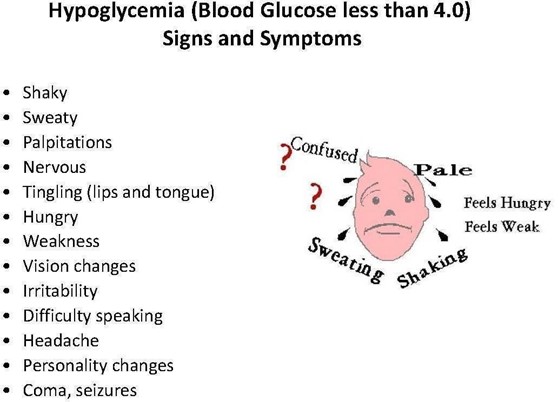The practical nurse (PN) is caring for a client newly diagnosed with diabetes mellitus (DM). Which finding is an early sign of hypoglycemia?
Polyuria.
Tremors.
Bradycardia.
Difficulty swallowing.
The Correct Answer is B
Hypoglycemia occurs when blood glucose levels drop below normal levels. It is commonly associated with diabetes mellitus and can result from various factors such as excessive insulin or oral hypoglycemic medication, delayed or missed meals, increased physical activity, or alcohol consumption.
Tremors, or shaking hands, are one of the early signs of hypoglycemia. They can occur due to the brain's response to low blood glucose levels. Other early signs of hypoglycemia may include sweating, palpitations, anxiety, hunger, and weakness.
A. Polyuria, or excessive urination, is not typically associated with hypoglycemia. It is more commonly seen in conditions such as hyperglycemia or diabetes insipidus.
C. Bradycardia, or a slow heart rate, is not a characteristic sign of hypoglycemia. It can occur in some cases of severe hypoglycemia, but it is not an early sign.
D. Difficulty swallowing is not directly related to hypoglycemia. It may be caused by other factors such as neurological or muscular conditions, esophageal disorders, or structural abnormalities in the throat or esophagus.

Nursing Test Bank
Naxlex Comprehensive Predictor Exams
Related Questions
Correct Answer is D
Explanation
Tramadol is an opioid analgesic that can depress the respiratory system and potentially cause respiratory depression. Therefore, it is crucial for the PN to closely monitor the client's breathing pattern, depth, and rate. Assessing for signs of shallow or slow breathing is important to detect any potential respiratory depression and take appropriate action promptly.
The other options listed are not directly related to the administration of tramadol:
A. Encouraging the client to resume normal activities after medication administration is not an appropriate intervention for a client experiencing torticollis. The focus should be on pain management, rest, and implementing measures to relieve the torticollis.
B. Observing the client for involuntary movements of the lips and tongue every day is not specifically related to tramadol. This intervention is more relevant to monitoring for tardive dyskinesia, a side effect associated with certain antipsychotic medications.
C. Performing a daily whisper test of the client's hearing to detect symptoms of ototoxicity is not necessary with tramadol. Ototoxicity refers to damage to the inner ear, often caused by specific medications, but tramadol is not known to cause ototoxic effects.
Correct Answer is B
Explanation
Bathing a bedfast client with the bed in a high position poses a potential risk to the client's safety. Lowering the bed to a safe height is important to prevent falls and injuries during the bathing procedure. The PN should promptly intervene and instruct the UAP to lower the bed to an appropriate level before continuing with the bathing process.
A. While remaining in the room to supervise the UAP is important, it should be done after ensuring the client's safety by lowering the bed. If the bed is not lowered, the risk of injury remains, and the PN should take immediate action to address the safety concern.
C. Determining if the UAP would like assistance is a valid consideration, but it should be secondary to addressing the safety issue of the bed height. Once the bed is lowered, the PN can assess if additional assistance is required and provide support accordingly.
D. Assuming care of the client immediately may be necessary if the client is in immediate danger or experiencing an urgent medical situation. However, in this case, the primary concern is addressing the safety issue related to the bed height, and the PN can address this by instructing the UAP to lower the bed.
Whether you are a student looking to ace your exams or a practicing nurse seeking to enhance your expertise , our nursing education contents will empower you with the confidence and competence to make a difference in the lives of patients and become a respected leader in the healthcare field.
Visit Naxlex, invest in your future and unlock endless possibilities with our unparalleled nursing education contents today
Report Wrong Answer on the Current Question
Do you disagree with the answer? If yes, what is your expected answer? Explain.
Kindly be descriptive with the issue you are facing.
